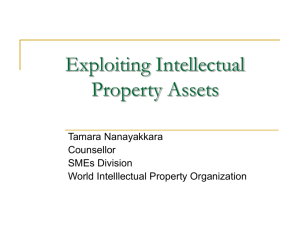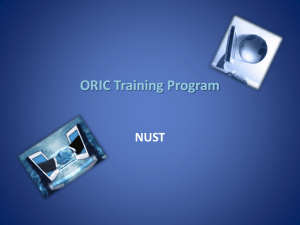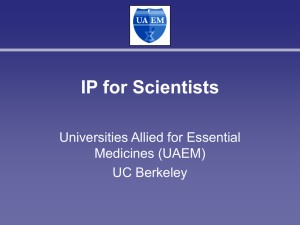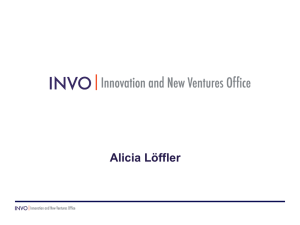University Industry Partnerships: Role of Intellectual Property
advertisement
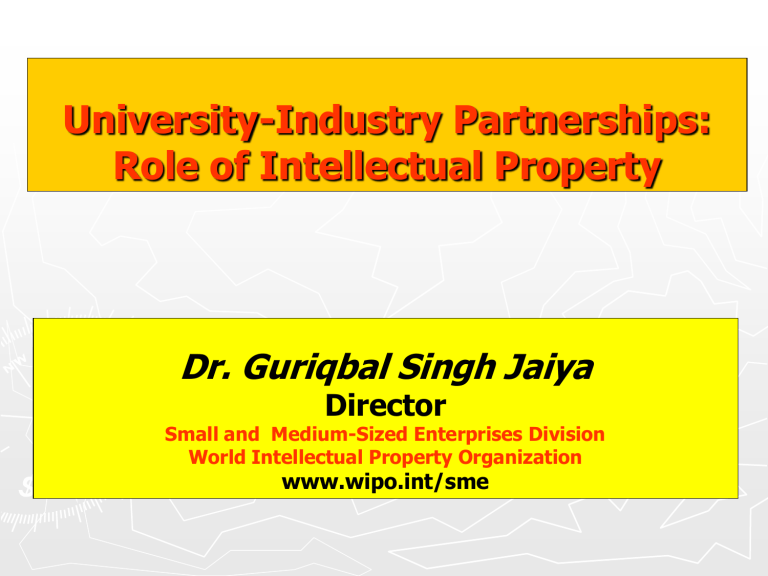
University-Industry Partnerships: Role of Intellectual Property Dr. Guriqbal Singh Jaiya Director Small and Medium-Sized Enterprises Division World Intellectual Property Organization www.wipo.int/sme KNOWLEDGE AGE Universities and high schools become the raw material of economic development as coal mines were the raw material of the industrial age ! The 21st Century Context for Linking Universities and the Economy ► The Knowledge Economy – A world-wide phenomenon ► Knowledge – The new raw material driving innovation, competitiveness, and economic development ► “Economic success is no longer determined by possession (e.g., of raw materials or physical prowess), but by capacity to generate new knowledge and by the ability of the workforce to apply this knowledge successfully” (M. Walshok, Knowledge Without Boundaries, 1995) The role of universities in the Europe of knowledge ► Develop effective and close co-operation between universities and industry innovation start-up of new companies licensing of university intellectual property promotion of effective university-industry relations better exploit the results of their knowledge in relationship with industry evaluation criteria for the performance of universities SUCCESS FACTORS FOR TECHNOLOGY TRANSFER Academic Business Government Community Talent Technology Capital Know-How Market - Need Successful Value-Added Technology Transfer G. Kozmetzky UT-Austin Ecosystem Investors’s [Thanks to Jeff Skinner, UCL] Lawyers Head hunters Other start-ups PR agents Patent Firms Real estate Accountants Leasing Brokers Itinerant managers Consultants Banks Students But why does the government invest in research? Government Funding of Basic Research In Academia Reservoir of Knowledge Increased Efficiency New Industry Taxes Science, The Endless Frontier, 1945 New Companies (Jobs) Vannevar Bush Reservoir Theory of Knowledge The Business of Academic Research Federal dollars to Universities have continued to climb, even while falling in other sectors Source: National Science Board Report 2002 Traditional academic roles • Research • Creation of new knowledge • Breakthroughs and basis research (about half of all basic research in U.S. conducted by universities) • Incremental technical advances • Education • Dissemination of knowledge • Graduation of students • Service • Transfer of knowledge and transfer of technology The Technology Transfer Process 7-12 YEARS SCIENCE & TECH MARKETING Technology Feasibility Idea Prototype/ Scale-up INVENTION Market R&D Pro-forma Business Plan FEASIBILITY Product Development Initial Manufacture COMMERCIALIZATION TRANSLATION Applications Marketing Strategy Business Plan MARKET CAPTURE MARKET & BUSINESS PLANNING IPO FINANCING Tech Tfr Funds Seed Capital Expansion Capital RETURNS Technology Licensing at Stanford ► Notable Inventions from Stanford Research 1971- FM Sound Synthesis ($22.9M) 1974 – Recombinant DNA ($255M) 1981 – Phycobiliproteins ($46.3M), Fiber Optic Amplifier ($32M), MINOS ($3.4M) 1982 – Amplification of Genes ($30M) 1984 – Functional Antibodies ($120.6M) 1986 – CHEF Electrophoresis ($2.1M) 1990-1992 – DSL ($28.7M) 1996 – Improved Hypertext Searching (GoogleTM ($336.5M) University-Industry partnerships: Economic Advantages ► Licensing agreements are only a small part of the benefits university research generates. Others include: ► Generation of new knowledge ► Creation of human capital ► Transfer of tacit knowledge ► Technological innovation ► Capital investment ► Regional leadership ► Production of knowledge infrastructure ► Influence on the regional milieu SUCCESS FACTORS FOR TECHNOLOGY TRANSFER Academic Business Government Community Talent Technology Capital Know-How Market - Need Successful Value-Added Technology Transfer G. Kozmetzky UT-Austin Conflicting Values - Common Interest UNIVERSITY Knowledge for Knowledge’s Sake INDUSTRY Management of Knowledge for Profit Teaching Research Service Economic Development Academic Freedom Open Discourse Profits Commercialization of New and Useful Technologies Product R&D Confidentiality Limited Public Disclosure Blending the University Research and Entrepreneurial Cultures ► Academics ► Industry research priorities set by investigator research priorities set by management grant-seeking profit-seeking publications proprietary patenting driven by publications patenting driven by business decisions serendipity control transfer at early stage add value before transferring Blending the University Research and Entrepreneurial Cultures Academic perspective; “Why partner with industry?” ► Application ► Exposure to industry collaboration ► Additional ► Build of research for public good source of research funds research endowment ► Reward investigator/inventor Blending the University Research and Entrepreneurial Cultures Industry perspective; “Why partner with universities?” ► Research institutions are rich source of new ideas and technology ► Cheaper to support research and to license-in technology ► Biotech industry looks to academic collaborations for early stage technology Blending the University Research and Entrepreneurial Cultures How do you begin to bring the two cultures together ? 1. Employment Policy 2. Policy of Intellectual Property 3. Revenue Sharing 4. Faculty Involvement Employment Policy ► Employer (University/College/Research Institute) owns all property rights to any intellectual property conceived and/or reduced to practice by its employees ► Assignment ► Salary, form part of orientation supplies, space, other resources of the University are utilized Policy on Intellectual Property ► Ownership ► Transfer of ownership ► Rights and obligations of faculty (employee) ► Rights and obligations of the University (employer) ► Royalty sharing ► Waivers The Bayh-Dole Act Public Law 96-517 Patent and Trademark Act of 1980 ► ► Allow small business and non-profit organizations to retain title to innovations made under federally-funded research programs Promote investment by the private sector in commercialization of federally funded research discoveries for the public good In Passing Bayh Dole, Congress recognizes… ► ► ► ► Creativity is truly a national resource The patent system in U.S. is the vehicle which permits delivery of the resource to the public It is in the public interest to place stewardship of research results in the hands of universities and small business Existing U.S. policy was ineffective at a time when intellectual property and innovation were becoming the preferred global currency Source: Howard Bremer, University Technology Transfer Evolution and Revolution, COGR, 1999. Bayh-Dole Provisions ► Encourage collaboration with industry to promote the utilization of inventions ► Disclosure to government within 2 months of invention ► Universities must file patents on inventions they elect to own, and share any monies with inventors ► Government retains non-exclusive license and march-in rights ► Requirement to attempt to develop the invention ► Preference to small businesses in granting licenses ► Products must be manufactured in the U.S. Bayh-Dole Act 1980 ► ► ► Allows universities to own and sell/license inventions/novations generated with federal dollars. Motivation: Get ideas off the shelf w/o sacrificing university mission (synergies) Generate university income for more research Critique: Increased commercialization of university research agenda Distraction from basic research (tradeoffs) Hold-ups/Anti-Commons approach to research Bayh - Dole Act 1980 ►Gives nonprofit organizations and small businesses the right to: retain title to inventions made in whole or in part with federal funds grant exclusive term-of-patent licenses The Technology Transfer Process 7-12 YEARS SCIENCE & TECH MARKETING Technology Feasibility Idea Prototype/ Scale-up INVENTION Market R&D Pro-forma Business Plan FEASIBILITY Product Development Initial Manufacture COMMERCIALIZATION TRANSLATION Applications Marketing Strategy Business Plan MARKET CAPTURE MARKET & BUSINESS PLANNING IPO FINANCING Tech Tfr Funds Seed Capital Expansion Capital RETURNS One University [Thanks to Jeff Skinner, UCL] Executive (policies) Gene pool Commercially active scientists Other academics Tech transfer office Why Do Universities Transfer Technology ► Generate licensing revenue and research funding ► Dissemination of new knowledge for the benefit of society ► Development of University technology into products ► Provide avenue for faculty members to interact with business ► Stimulate economic development ► Generate favorable publicity for the University Patents as source of research funding ► 25% of life scientists have a patent Median patent holder owns 2 patents ► Patents as the “academic’s lottery ticket” 33% of patent holders receive licensing revenues, representing 8% of all life scientists. Average royalties ~$16,500 per patent But in our sample: ► One patent accounts for ~90% of those royalties ► Of 1200 patents there are only three that make ~$1million or more. ► Median annual royalty income is $5,000 ► License revenues account for less than 1% of research budgets for those with patents Is there a commercialization of US university life sciences? ► 53% of life scientists in our survey have no engagement with industry No patents, invention disclosures, industry funding, service on industry boards, collaborations, etc. ► 20% of life scientists report private industry funding, accounting for 25% of research budgets They still get 54% from federal sources ► Overall in the life sciences, 67% of all research funding comes from federal sources, 15% from own university sources, 10% from private foundations, and only 5% from private industry. Percent of lab funding from different funding sources Source 66.9 Scientists who do 100% basic research 71.2* Own university 14.6 15.7 Foundations 9.5 9.7 Industry State government 5.3 2.4 0.8* 0.9* Federal All life scientists (NIH, NSF, etc.) * Significantly different at a 95% confidence level Evidence on hold-up problems: Percent of life scientists reporting constraints Not applicable None or minor constraint Some or major constraint Affordability of licensing intellectual property 61.5 33.6 4.9 Materials transfer agreements from another university 49.1 39.1 11.8 Materials transfer agreements from private industry 56.2 33.4 10.4 Funding Basic Research Very difficult to fund without federal money Patents unlikely to provide much help because ► ► “lottery” – unpredictable returns timing of liquidity (can’t borrow against expected licensing earnings). reinforced by basic nature of research that are less likely to generate valuable patents. Industry funding small and unlikely to ever be much more than that (time horizon) ► Good news that stem cells won’t likely be the Trojan horse that brings commercialization into the university Bad news that industry won’t fund enough of this research to make up for federal funding Overview of the Technology Commercialization Pathway Research IP Protection Invention Disclosure TTC Evaluation Licensing Strategy Invention Evaluation Process Invention Invention Disclosure Electronic Submission Technology Transfer Committee Technical Review Patent Search Market Analysis Technology Transfer Committee Patent Technology Release to Inventor Hold for Further Evaluation Test Market Invention Evaluation Process ► Is it protectable? Patent, copyright, know how ► Is it enforceable? Infringement ► Is it licensable? The primary reason for investing in intellectual property protection is the ability to license the invention. Evaluation Criteria ► Level of IP Protection ► Related Industry R&D Activity ► Inventor Reputation and Participation ► Inventor R&D Activity ► Promised Benefits and Novelty ► Market Size ► Competing Products ► Development Status and Time to Market ► Validation and Performance Overview of the Technology Commercialization Pathway Research IP Protection Invention Disclosure TTC Evaluation Licensing Strategy Licensing Strategy Intellectual Property Option Agreement License Agreement Start-Up Company Balancing Public Good vs. Practical concerns in IP Licensing Internal tensions: $ vs. altruism Non-exclusive or exclusive? (widespread access vs. investment incentive) Exclusive: requires incentives/disincentives Exclusive variations Significant upfront fees Effective royalties Appropriate minimums ** Patents costs Diligence milestones Legal and responsible use Field of use Sublicense incentives Return of rights consortia Non-exclusive with “sliding scales” of terms Licensing Strategy ► Option Agreement Early stage technology that requires further development Proof of principle – add value or reduce risk Reach some minimal level of progress to be of interest to investors Does not give rights to develop or sell products Exclusive or non-exclusive Convertible to license agreement on agreed terms Licensing Strategy ► License Agreement – Existing Company Technology likely to lead to a single product Small number of large firms that dominate the field ►Exclusive or non-exclusive Capital requirements to enter the industry prevent startups from being competitive Existing company may be able to get the technology to market faster Licensing Strategy ► Start-Up Company Formation Platform or disruptive technology with broad patent protection Ability to generate interest from investors ► Market size sufficient ► Gross margins attractive Viable business model Begins with an option agreement conditioned upon milestones ► Investment ► Management team Technology Marketing ► Inventors are the single most important step in marketing 70% of licensing leads come from the inventor ► Identify companies in technology area ► Network at scientific and industry conferences ► Respond in a timely manner ► Have a plan for next steps in research ► Forward all licensing interest to the OTM Technology Marketing ►OTM Marketing Efforts Technologies available for licensing are on the OTM web site Focused business development relationships in specific technology areas Relationships with local and national venture capital groups Industry conferences Overview of the Technology Commercialization Pathway Research IP Protection Invention Disclosure TTC Evaluation Licensing Strategy Licensing Process ► Identification of interest ► Confidentiality agreement for scientific and IP due diligence ► Discussion of license type Option versus license agreement Exclusive versus non-exclusive ► Negotiation terms of financial, business, and legal License Agreement terms ► License Exclusive or non-exclusive Field of use Territory License term ► License grant Consideration Upfront fee Maintenance fees / Minimum annual royalty Royalties Other – Milestones, equity University Approach to StartUp Company Formation PLATFORM TECHNOLOGY LEAD MANAGEMENT CORPORATE PARTNER/ SOPHISTICATED VC SEED FUNDING Faculty Involvement with Start-Up Companies ► Permitted activities Holding of equity Sponsored research from company Consulting relationship Scientific Advisory Board Entrepreneurial leave ► Prohibited activities Holding of greater than 20% equity Serving as PI for sponsored animal research or clinical study Holding Board of Directors seat Holding management position in licensing company Faculty start‐ups: “Best Practices” ► ► ► ► ► ► ► ► ► ► ► ► ► ► ► ► Faculty must • Separate their on‐going University research from company work • Understand that their primary commitment is to the University – Only advisory/consulting roles with the company – Limit consulting for the company to 13 days a quarter, per University policy • Take a leave of absence if engaging in a management role Faculty must not • Negotiate with the University on behalf of the company • Receive gifts or sponsored research from the company • Involve University staff in activities at the company • Involve company personnel in Stanford research • Involve current students in company activities • Involve junior faculty who are in a dependent role in company activities • Use University facilities for company purposes • Undertake human subjects research or supervise faculty who are human subjects protocol directors for work related to the company’s interests Background/Context ► Faculty Consulting Rationale – having faculty engaged with the corporate community may provide important opportunities to advance science and research and quality of medicine and patient care BUT there are issues and problems that must be addressed. Responsibilities ► Faculty Member’s responsibilities Understand University policies relating to conflict of interest, intellectual property, time allowed for consulting, etc. Understand what you’re signing ! University’s responsibilities ► Disclosure obligation ► ► What’s the norm for consulting in Industry? Issues – The Consulting Plus Dilemma ►Conflicts of Interest and conflicts of commitment – Consulting + sponsored research Consulting + equity ownership Consulting + management position Consulting + clinical trial (human subjects) Use newspaper test Issues ► Intellectual Property: Company’s general rule: The company owns any intellectual property created by the consultant that relates to the research he/she does for the company” ► How does this impact the Consultant’s research with the University: Scope of work – length of time (e.g. broad vs. narrow scope, one-day speakers’ board versus two year consulting relationship) IP ownership – (remember: disclosure to UR). If Company owns it, you lose the right to use it in your research Potential to compromise future research work or funding Terms suggested by industry are getting broader and broader Issues ►Confidentiality and Publication Rights Is it clear what information is considered to be confidential? Freedom to publish ►Indemnification and Limitation of Liability General comments on liability Consultant indemnifying Company Company indemnifying Consultant Try to limit your liability for the work you perform Issues ► Exclusivity Does the contract provide that you can’t do “overlapping” or “related” research for others? Other language purporting to restrict you or the University? ► Use of University resources in the consulting arrangement (includes space, equipment, students, etc.) ► Tax Issues related to receipt of consulting income TECHNOLOGY TRANSFER, INTELLECTUAL PROPERTY AND EFFECTIVE UNIVERSITY-INDUSTRY PARTNERSHIPS: The Experience of China, India, Japan, Philippines, the Republicof Korea, Singapore and Thailand ► http://www.wipo.int/freepublications/en/int property/928/wipo_pub_928.pdf
![Introduction [max 1 pg]](http://s3.studylib.net/store/data/007168054_1-d63441680c3a2b0b41ae7f89ed2aefb8-300x300.png)
